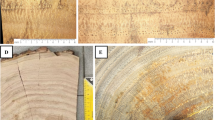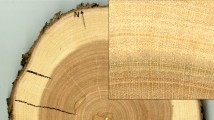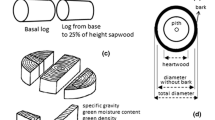Summary
In the West African Ilomba wood (Pycnanthus angolensis Exell) discolourations frequently develop after felling, which lead to serious degradation with regard to utilization. Therefore, structure and chemical composition of normal and discoloured wood were investigated in order to characterize the original wood and give a detailed account of the reactions which lead to discolourations. According to the results Ilomba, in normal condition, is all sapwood, which explains its high reactivity. The species does not have the ability to develop heartwood; only false heartwood is formed, initiated by exogenous influences. Discolourations arising in the wood after felling are reddish-brown, due to the deposition of extraneous compounds in the lumina of the ray cells. Soluble sugars disappear and the permeability decreases as a result of tyloses development. From discoloured wood only 60% of extraneous compounds could be extracted as compared to the normal sapwood, thus indicating that polymerisation of extraneous compounds takes place. Discoloured wood appears even more susceptible to decay than the bright sapwood. The pH-value increases from about 5.5 to 7.5 during discolouration, and bacteria present within the reddish-brown zones are involved in that process.
Similar content being viewed by others
References
Bauch, J. 1980: Variation of wood due to secondary changes. Mitteilungen der Bundesforschungsanstalt für Forst- und Holzwirtschaft, Hamburg-Reinbek Nr. 131: 69–97
Bauch, J.; Seehann, G.; Endeward, R. 1982: Characterization of sapwood and brown heart in Terminalia superba Engl. et Diels. Holzforschung 36: 153–160
Bavendamm, W.; Schneider, I.; Mielke, H. 1963: Ergebnisse einer Schiffsforschungsreise nach Äquatorialafrika zwecks Untersuchung von Importholzschäden. Holz Roh- Werkstoff 21: 1–13
Bosshard, H. H. 1968: On the formation of facultatively coloured heartwood in Beilschmiedia tawa. Wood Sci. Technol. 2: 1–12
Cosenza, J.; Mc Creary, M.; Buck, J. D.; Shigo, A. L. 1970: Bacteria associated with discolored and decayed tissues in beech, birch, and maple. Phytopathology 60: 1547–1551
Findlay, W. P. K. 1959: Sap-stain of timber. For. Abstr. 20 (1–7): 167–174
Fougerousse, M. 1959: Das Problem des Schutzes frischer Hölzer in den Tropen. Mittlg. DGfH Nr. 46: 6–7
Höster, H.-R. 1974: Verfärbungen bei Buchenholz nach Wasserlagerung. Holz Roh- Werk-stoff 32: 270–277
Karstedt, P.; Liese, W.; Willeitner, H. 1971: Untersuchungen zur Verhütung von Transportschäden bei anfälligen Tropenholzarten. Holz Roh- Werkstoff 29: 409–415
Liese, W.; Bauch, J. 1977: Untersuchungen über die Wegsamkeit saftfrischen Splintholzes von Fichte und Sitkafichte. Holz Roh- Werkstoff 35: 267–271
Murmanis, L. 1975: Formation of tyloses in felled Quercus rubra L. Wood Sci. Technol. 9: 3–14
Neger, F. W. 1910: Vergrünung des frischen Lindenholzes. Naturw. Z. f. Forst- u. Landw. 8: 305–313
Neger, F. W. 1911: Die Rötung des frischen Erlenholzes. Naturw. Z. f. Forst- u. Landw. 9: 96–105
Rafalsky, H. J.; Kirk, H.; Achterberg, W. 1967: Zum Problem der Holzfeuchte im Wald lagernden Stammholzes und deren Auswirkungen. Soz. Forstw. 18: 51–54
Romeis, B. 1968: Mikroskopische Technik. München, Wien: Oldenburg-Verlag
Schink, B.; Ward, J. C.; Zeikus, J. G. 1981: Microbiology of wetwood: Role of anaerobe bacterial populations in living trees. J. Gen. Microbiol. 123: 313–322
Seehann, G. 1976: Zur Pilzresistenz von Khaya. Holz Roh- Werkstoff 34: 465–468
Shigo, A. L.; Hillis, W. E. 1973: Heartwood, discoloured wood and microorganisms in living trees. Ann. Rev. Phytopath. 11: 179–222
Shortle, W. C.; Cowling, E. B. 1978: Development of discoloration, decay, and microorganisms following wounding of sweetgum and yellow poplar trees. Phytophatology 68: 609–616
Simatupang, M.; H. H. Dietrichs 1978: Neocuproin als Nachweisreagenz reduzierender Zucker bei der Ionenaustausch-Chromatographie. Chromatographia 2: 89–95
Starck, M. 1982: Verfärbungen von Ilombaholz (Pycnanthus angolensis Exell) bei Transport und Lagerung. Dissertation, Universität Hamburg, 138 S
De Stefanis, V. A.; Ponte, J. G. Jr. 1968: Separation of sugars by thin layer chromatography. J. Chromatog. 34: 116–120
Tattar, T. A.; Rich, A. E. 1973: Extractable phenols in clear, discolored and decayed woody tissues and bark of sugar maple and red maple. Phytopathology 63: 167–169
Wagenführ, R. 1979: Holzeigenschaftstafel Ilomba. Holztechnologie 20: 2
Zimmermann, G. 1974: Untersuchungen über Art und Ursachen von Verfärbungen an Bergahornstammholz (Acer pseudopl. L.). Forstw. Cbl. 93: 247–261
Author information
Authors and Affiliations
Additional information
We are indebted to Mrs. R. Endeward for assistance in the experimental work, to Prof. N. Parameswaran for support in the REM work, to Fa. Bernhard, Wangen and to Mr. K.-G. Dahms, Hamburg, for the supply of Ilomba wood. Acknowledgement is given to Deutsche Forschungsgemeinschaft for financial support
Rights and permissions
About this article
Cite this article
Starck, M., Bauch, J. & Simatupang, M.H. Characteristics of normal and discoloured wood of Ilomba (Pycnanthus angolensis Exell). Wood Sci. Technol. 18, 243–253 (1984). https://doi.org/10.1007/BF00353359
Received:
Issue Date:
DOI: https://doi.org/10.1007/BF00353359




